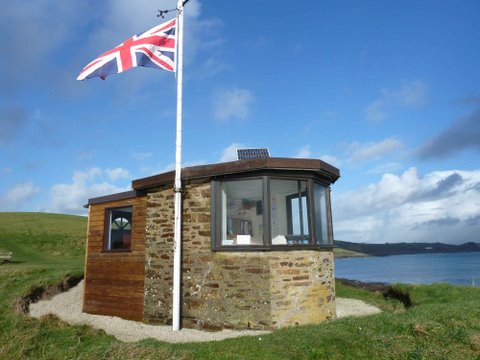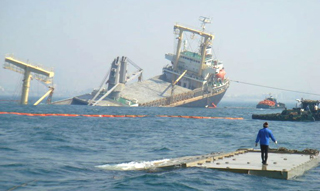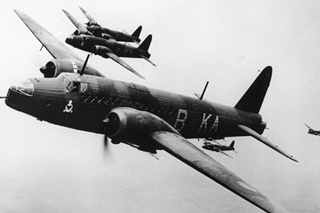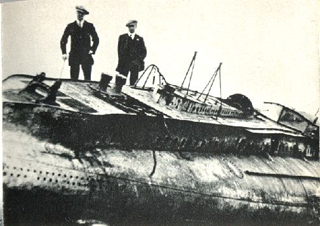Our Own Private Shipwreck
 Watching out from our Lookout on a fine summers day it seems impossible that the area in front of us has been the scene of ship wreck, tragedy and drowning for thousands of years. We cannot see the Manacles off Coverack as our view is obstructed by Pencabe Point but in the other direction we can see as far as Dodman and, on a clear day, the sea beyond.
Watching out from our Lookout on a fine summers day it seems impossible that the area in front of us has been the scene of ship wreck, tragedy and drowning for thousands of years. We cannot see the Manacles off Coverack as our view is obstructed by Pencabe Point but in the other direction we can see as far as Dodman and, on a clear day, the sea beyond.
Like all of the Cornish Coast, battered by storms, shrouded in fog, it has seen the death of many a fine ship. The nearest and most recent was the wreck of the bulk carrier ‘Toledo’, beached in Gerrans Bay in 1990, only a few hundred yards off Pendower Beach. If she were there now she would be on our doorstep, dominating the scene and the focus of much tourist attraction. As it was the story unfolded in the winter of 1990 and by the time the ‘season’ opened, there was little to see.
‘Toledo’ loaded potash in St John’s, Canada, and sailed on February 13th, bound for Denmark. The weather was typical for that time of year and the ship was battered as she crossed the Atlantic. On February 20th the Master noticed that the ship felt strange and that, from time to time, the water in her wake was coloured red. From this he deduced that there must be a leak and that the sea was washing in and out of the cargo hold.
 Realising he was in trouble he altered course and headed towards Cork in Ireland and sent out a Mayday call. Another ship came and stood by him and a rescue tug, ‘Simpson’, was sent. to her aid. The ship was 250 miles from Bantry Bay in Ireland and the Master was confident that he could reach there, but decided, as a precaution, to have most of the crew taken off by helicopter. While this was going on water pressure blew off a main hatch and it was decided to evacuate the whole crew.
Realising he was in trouble he altered course and headed towards Cork in Ireland and sent out a Mayday call. Another ship came and stood by him and a rescue tug, ‘Simpson’, was sent. to her aid. The ship was 250 miles from Bantry Bay in Ireland and the Master was confident that he could reach there, but decided, as a precaution, to have most of the crew taken off by helicopter. While this was going on water pressure blew off a main hatch and it was decided to evacuate the whole crew.
It still seemed like that the ‘Simpson’ would be able to take the casualty to Cork but the Irish Government refused to allow her to enter Irish waters. Falmouth then became her destination but the poor weather and her deteriorating condition meant that she would not be allowed entry in case she sank on the way in. She was, after all, and abandoned hulk. The decision was taken to beach her in Gerrans Bay, which was done at three quarter tide on March 3rd.
So there she lay only a few hundred yards off the beach and no great distance from our Lookout – not that it was in use at the time. She was to remain there until April 24th, during which time her cargo was pumped out into the sea, being regarded as relatively harmless. She was then re-floated,’ towed out to sea and eventually scuttled in deep water 210 miles from Lands End. I can remember a lot of activity around the beach at the time but road access is so poor that most work was done from the sea. When she was gone, however, there remained on the beach for several weeks two very large rusty objects which could, perhaps, been the remains of pontoons. Everyone thought they would become a permanent and dangerous feature but, in the end, they were cut up and taken away.
 The ‘Toledo’ is not the only known wreck in Veryan and Gerrans Bays. Discounting the well known ‘Hera’ out by Nare Head, there lies somewhere in Veryan Bay the wreckage of a World War 2 Wellington bomber which is believed to be all that remains of a crash in 1944 when a plane from Davidstowe crashed on a training flight.
The ‘Toledo’ is not the only known wreck in Veryan and Gerrans Bays. Discounting the well known ‘Hera’ out by Nare Head, there lies somewhere in Veryan Bay the wreckage of a World War 2 Wellington bomber which is believed to be all that remains of a crash in 1944 when a plane from Davidstowe crashed on a training flight.
The exact reason for the crash is unknown, only that the pilot lost control. There were six airmen on board but only three were rescued. The precise site is not well known except to the divers who originally discovered a trail of aluminium wreckage and an engine. Their view is that this is a war grave and should remain undisturbed – there is little to see, anyway, though, over the years, fishermen working the Bay have occasionally pulled up bits of aluminium.
Not surprisingly Falmouth harbour and bay are littered with wrecks. Many lives were lost, sometimes even within the harbour area itself. None of these are visible to us in the Lookout but the remains of German submarines can still be seen on a very low tide from Castle Drive on the way out to Pendennis Point. At the end of World War 1 the German Navy surrendered itself at Scappa Flow. While many large ships were scuttled a quantity of submarines fell intact into British hands.
These were divided up among the victors, nine of them going to the British navy for use as targets and experimental work. They were towed to Falmouth and anchored off Gullyngvase Beach. Two were used as targets and sank out in the Bay but a storm blew up and the rest were driven ashore and scattered along the rocks of Castle Point. They have been heavily salvaged over the years but ribs and metalwork can still be seen on a low spring tide.
 Wrecks in our area attract divers and dive boats with their blue and white flags are common. By far the most popular site is, of course, the ‘Hera’, a good clear dive in fairly sheltered water. Dive boats are always of interest to us and their presence is carefully logged. Mishaps are rare but they do happen and to my personal knowledge there have been three occasions in the last four years when a diver has got in difficulties.
Wrecks in our area attract divers and dive boats with their blue and white flags are common. By far the most popular site is, of course, the ‘Hera’, a good clear dive in fairly sheltered water. Dive boats are always of interest to us and their presence is carefully logged. Mishaps are rare but they do happen and to my personal knowledge there have been three occasions in the last four years when a diver has got in difficulties.
The crews of the boats are professional and know what to do, First Aid is administered on the spot and the lifeboat called. Dive boat and RHIB then meet somewhere off Pencabe, the casualty is transferred and the faster RHIB heads for Falmouth. Our concern is to make sure that the message from the dive boat has got through to Coastguard and we can act as a relay point if not.
Our essential duty is communication, we are there to see the message gets through. Maybe we will start the message off from something we have seen and other times we will listen to calls to Falmouth and ensure that they have been heard. The area we cover is invisible to Falmouth not only from sight but often also from radio. All of us who live here are aware of the vagaries of mobile telephone communication and that, in effect, is what a marine radio is.
Just like your phone it sends a signal without wires to another point. If it cannot ‘see’ that point the message might not get through. That is why we man the Lookout six days a week during spring, summer and autumn. We need more volunteers so we can give cover every day of the week. Why should it be easier to drown on a Tuesday than on a Wednesday, simply because there is no one in the Lookout to see your problem? Come along and see if you can help. Make a short walk out to the Lookout one day when the flag is flying and see what we do. Failing that give Robert a ring on 01872-501670.
Pictures by courtesy of Wikepedia

